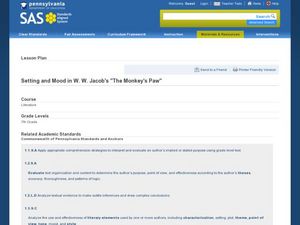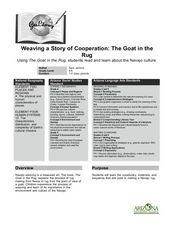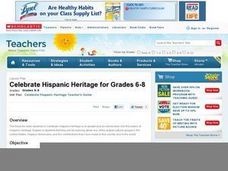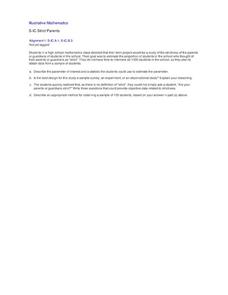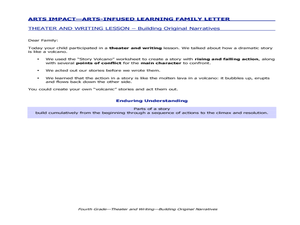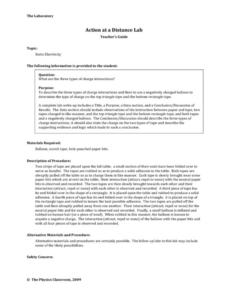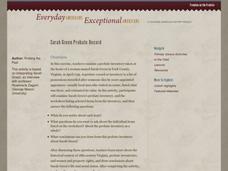Brigham Young University
The True Confessions of Charlotte Doyle: Biopoem
Conclude your novel study of The True Confessions of Charlotte Doyle by Avi with this biopoem activity. Get an in-depth look into the personal interests of the poem's subject including feelings, needs, fears, and more!
Syracuse University
Women's Suffrage Movement
Women gained the right to vote in the twentieth century, but the fight for equality dates back centuries. Using an invitation to an 1874 suffrage convention, eager historians consider the motivations behind supporters of the suffrage...
Prestwick House
Reading Nonfiction: Analyzing Joseph McCarthy's "Enemies from Within" Speech
Looking for a instructional activity that teaches class members how to analyze nonfiction? Use Joseph McCarthy's famous "Enemies from Within" speech as a instructional text. Worksheet questions direct readers' attention to the many...
Curated OER
The Importance Setting and Mood in Fiction
Seventh graders examine the setting in pieces of fiction. In this story analysis lesson, 7th graders investigate the setting in fictional stories and the importance it has. Students discover new vocabulary terms applying to storytelling.
Curated OER
Prize Numbers
Students explore what a proof is, how and why mathematicians create them and compose essays on how reason and logic are employed in the workplace. They explore whether any three lines can make a triangle and attempt to verify Goldbach's...
Alabama Learning Exchange
Systems Every "Body" Needs to Know
Through an informative WebQuest and group work, learners explore the human body and cell structure. They create a cell diagram, research a disease, write a letter explaining the causes of human disease, and work in small groups to create...
Curated OER
Greek Inquiry Report and Presentation
Sixth graders choose from a list of researchable inquiry questions. They engage in all phases of inquiry/research process.
Curated OER
Novel endings
Students explore writing techniques. They investigate stories and their endings. Students discuss good ending tips. Students write a story about a main character overcoming a problem and write a good ending.
Curated OER
Scientific Method Conclusion- Adjective Practice
For this adjectives worksheet, students write adjectives that describe a well-written scientific conclusion on lines around a light bulb, then write a sentence for 4 of the adjectives used.
Curated OER
Weaving a Story of Cooperation: The Goat in the Rug
Weaving is an important part of Navajo culture. Read The Goat in the Rug to your fourth and fifth graders, and give them a glimpse into the process of rug making from the point of view of a goat! They will learn new vocabulary words and...
Curated OER
Celebrate Hispanic Heritage: Grades 6-8
To gain a better understanding of Hispanic heritage and culture, as well as to build informational comprehension skill, learners explore facets of Hispanic American History. They engage in a class discussion, research three facts, and...
Curated OER
Creating Historians: Giving Scholars the Answers
How allowing index cards on tests can empower critical thinking; part one of a series on approaching social studies as a group of historians.
Curated OER
Strict Parents
Are your parents or guardians strict? That's an interesting question many of your pupils are probably interested in discussing. How do you design a study directed at your high schooler to gain insight into that question? How do you...
Curated OER
Measuring Angles
Solve and complete 18 problems about angles. First, demonstrate that each conjecture is false by giving a counterexample. Then write the inverse, contrapositive, and converse for the each statement. In addition, write a biconditional...
Curated OER
Dramatic Outlines
Young scholars write about main characters. In this dramatic writing lesson, students brainstorm character ideas. Young scholars create actions and give the character a voice. Students act out the scene in groups and create a final draft.
Santa Barbara City College
Structure of a General Expository Essay
A great student reference tool and graphic organizer in one worksheet! Young writers can read a detailed description of each section of a standard five-paragraph essay before completing a graphic organized with their own writing. The...
Cornell University
Plant Cell Crime Scene
Use science to solve the mystery of the Poplar murder. Pupils use forensic botany to determine if a suspect could be the killer. By analyzing images from a Transmission Electron Microscope, learners determine if the material found on the...
Curated OER
Noncombatancy and the Seventh day Adventist Church
Upper graders investigate how the Seventh Day Adventists are objectors to the practice of war. The lesson covers the Civil War and examines the church's position about the practice of war. The research extends to modern wars and learners...
Curated OER
Building Original Narratives
Fourth graders act out and write original narratives. In this theater meets writing lesson, 4th graders work in groups to create original narratives; after students act out their story, they write it down as a narrative.
Physics Classroom
Action at a Distance Lab
The concepts involved with static electricity are typically taught in upper elementary physical science units. The lab described in this resource has pupils examine the behavior of small pieces of paper and a balloon when a charged piece...
Anchorage School District
Flexibility Wall Poster
All paragraphs do not have to be the same! Let your class know with a poster that demonstrates five different paragraph styles, ranging from a six-sentence paragraph to a ten-sentence paragraph. Each style includes a brief sample outline...
Roy Rosenzweig Center for History and New Media
Sarah Green Probate Record
The proof is in the probate record. Much can be learned about history by investigating old, primary source documents. Class members hone their detective skills by examing the 1759 probate record of Sarah Green. Who was this lady? Was she...
Virginia Department of Education
Inductive and Deductive Reasoning
Introduce pupils to the two types of reasoning, inductive and deductive. Classmates work in pairs or small groups to learn the difference between the two and apply these reasonings to develop valid conclusions.
Curated OER
Microbes That Are Your Buddies - Biology Teaching Thesis
High schoolers analyze experimental data and draw conclusions. They are able to comprehend that not all microbes are harmful--they can be helpful to humans. Students are able to comprehend specific examples of cases in which microbes are...





